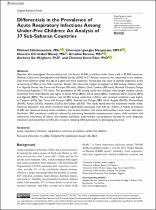| dc.contributor.author | Okonji, Osaretin Christabel | |
| dc.contributor.author | Ekholuenetale, Michael | |
| dc.contributor.author | Nzoputam, Chimezie Igwegbe | |
| dc.contributor.author | Barrow, Amadou | |
| dc.contributor.author | Wegbom, Anthony Ike | |
| dc.contributor.author | Edet, Clement Kevin | |
| dc.date.accessioned | 2023-04-12T08:21:18Z | |
| dc.date.available | 2023-04-12T08:21:18Z | |
| dc.date.issued | 2023-01-26 | |
| dc.identifier.citation | Ekholuenetale, Nzoputam, C. I., Okonji, O. C., Barrow, A., Wegbom, A. I., & Edet, C. K. (2023). Differentials in the Prevalence of Acute Respiratory Infections Among Under-Five Children: An Analysis of 37 Sub-Saharan Countries. Global Pediatric Health, 10, 2333794X231156715–2333794X231156715. https://doi.org/10.1177/2333794X231156715 | en_US |
| dc.identifier.issn | 2333-794X | |
| dc.identifier.uri | http://hdl.handle.net/10566/8760 | |
| dc.description.abstract | Objective. We investigated the prevalence and risk factors of ARI in children under 5years old in 37 SSA countries.
Methods. Data from Demographic and Health Survey (DHS) of 37 African countries was examined in this analysis.
Data from children under the age of 5 years old were examined. Forest plot was used to identify disparities in the
occurrence of ARIs across SSA countries. Results. We observed a higher prevalence of ARI among children under
5 in Uganda, Kenya, Sao Tome and Principe (9% each), Gabon, Chad, Eswatini (8% each), Burundi, Ethiopia, Congo
Democratic Republic (7.0% each). The prevalence of ARI among under-five children who sought medical advice/
treatment from health facility was higher in South Africa (88%), Sierra Leone (86%), Tanzanian (85%), Guinea (83%)
and Uganda (80%). The prevalence rate of ARI among under-five children who received antibiotics was higher
in Tanzania (61%), Sao Tome and Principe (60%), Rwanda and Congo (58% each), Angola (56.0%), Mozambique
(54.0%), Kenya (53.0%), Namibia (52.0%) and Gabon (50.0%). This study found that the household wealth index,
maternal education, and urban residence were significantly associated with ARI (p<0.001). A higher prevalence
of ARI was observed among urban residents, low income families, and those with mothers with lower education.
Conclusion. ARI prevalence could be reduced by improving household socioeconomic status, child nutrition and
community awareness of indoor and outdoor pollution. Interventions and programs focused on early diagnosis,
treatment and prevention of ARIs are crucial in reducing ARIs particularly in developing countries. | en_US |
| dc.language.iso | en | en_US |
| dc.publisher | Sage | en_US |
| dc.subject | acute respiratory infection | en_US |
| dc.subject | sub-Saharan countries | en_US |
| dc.subject | prevalence | en_US |
| dc.subject | under-five children | en_US |
| dc.title | Differentials in the prevalence of acute respiratory infections among under-five children: An analysis of 37 sub-Saharan countries | en_US |
| dc.type | Article | en_US |

